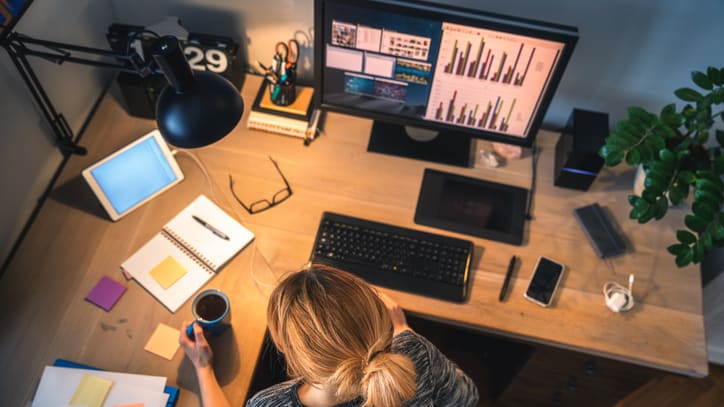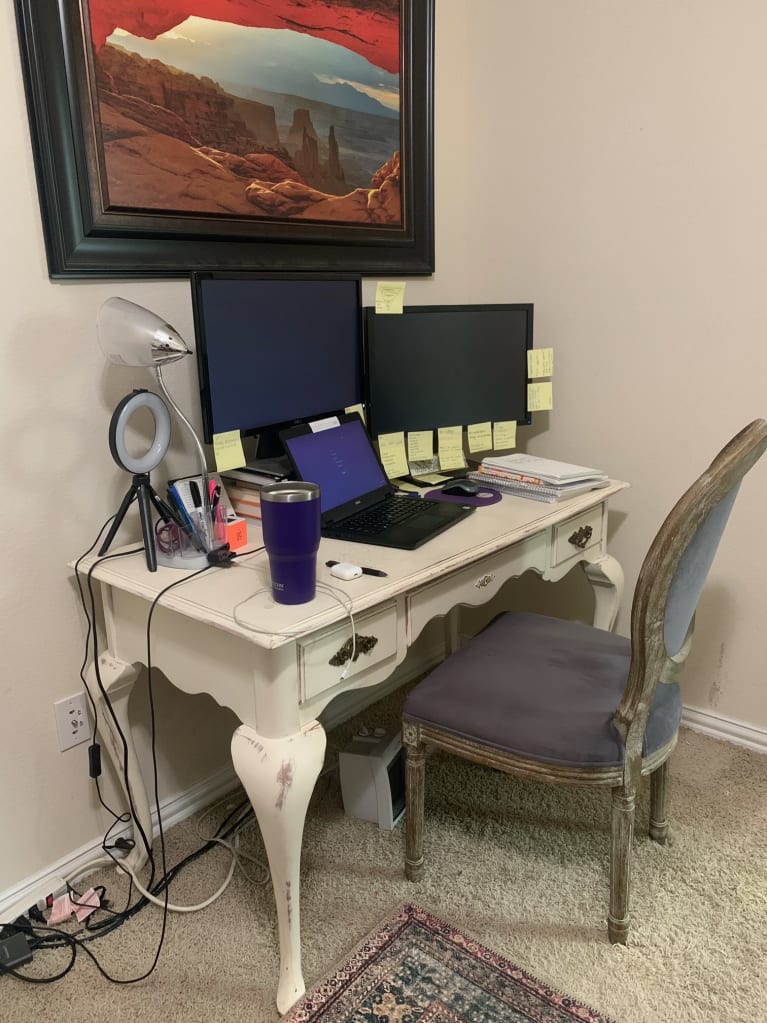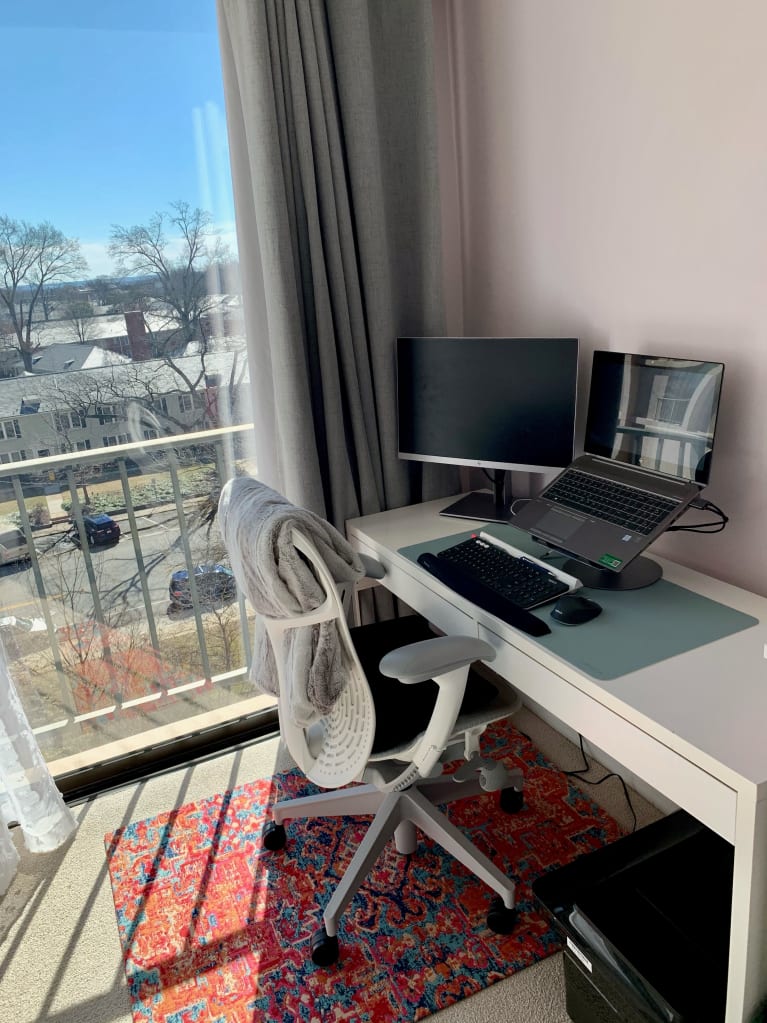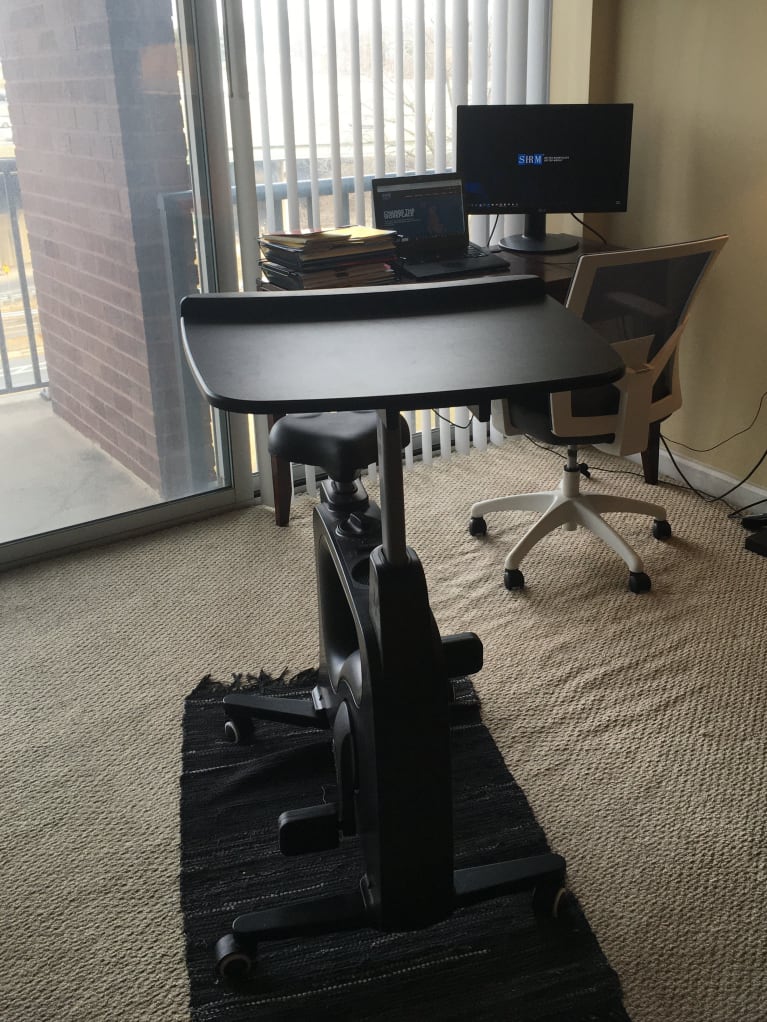Creating the Ideal Work-from-Home Office
HR pros share their DIY experiences building home workstations during the pandemic

Driven by necessity, productivity and comfort, millions of office workers have been experimenting with makeshift workstations since the COVID-19 pandemic sent them home about one year ago.
Some remote employees adjusted immediately; others took more time to get into the work-from-home (WFH) groove; and still others are looking forward to getting back into the office, where they feel they do their best work.
The best-situated at-home workers moved into home offices, making the transition to remote work easy, while others inhabit bedroom corners and kitchen tables, work from couches and balconies, and take calls in the bathroom so as not to disturb family members and partners sharing their co-working space.
SHRM Online asked a few HR professionals to share how they've adapted to working from home, what they had to say about their favorite WFH setups and tips to enhance the remote-work experience.

Alexandra Obanion, lead recruiter and talent advisor at Celanese, a chemical technology company based in Dallas
Obanion, living in Houston, has been working from home since Celanese shifted its workforce to remote work in March 2020. "I initially set up shop at the kitchen table with my laptop and an additional monitor, but after a few months, when going back into the office was not an option for the foreseeable future, I invested in a full-office setup in my spare bedroom," she said.
Sharing her office with an extra bed felt ad hoc, so she got rid of the bed and put in a couch and chair instead, working toward a complete office makeover.
Obanion's workstation consists of a laptop and two additional monitors. She plans to purchase a laptop dock with an additional screen and keyboard as well as an ergonomic chair.
There are pros and cons to working from home, she said. While she loves spending the day with her at-home co-workers—a Pomeranian and a German shepherd— and benefits from preparing healthier meals at home and saving money not eating lunch at restaurants, there are downsides, including the "terrible work/life balance. Yes, the commute from your bed to your home office is nice, but where do we draw the line from work/office to home/life?" she said. "It's too easy to work into the evening, and before you know it, you've worked a 12-hour day."
WFH Tip: Block time for tasks, stay on task and know when to shut down for the day.

Cheryl Jones, human resources information system analyst at Inova Health System, based in Falls Church, Va.
Jones held off from building a full workstation in the early days of the pandemic—moving her laptop around her one-bedroom condo in Arlington, Va.—when it wasn't clear how long she would be working from home. After a few months passed, she decided to set up something more comfortable and permanent. "Having a dedicated workstation really improved my productivity," she said.
Jones set up a desk in her bedroom "facing away from my bed and right next to a window—it's quite comfortable," she said.
She was initially using her personal laptop, but eventually received a laptop from work as well as a Cisco Meraki box, which manages multiple devices. She brought home a second monitor from work and bought a desk, a keyboard and mouse that can be used between multiple platforms, a laptop stand, and an ergonomic chair, "which has made all the difference in comfort and health," she said.
Being next to a floor-to-ceiling window overlooking a tranquil suburban neighborhood is what Jones likes best about her home workstation. "The view brings me a sense of calmness that working in my office did not. Also, my office at work was shared space, and I enjoy the privacy that my work-from-home space provides," she said.
WFH Tip: Find some self-care time during the day to ensure you can re-energize. For example, take at least a 30-minute lunch break away from your computer, step outside for a 30-minute walk or complete a workout video.

Mike Jackson, SHRM-CP, manager of employee experience at the Society for Human Resource Management (SHRM), based in Alexandria, Va.
Jackson, who was new to WFH, converted his home desk into a workspace when SHRM asked its employees to work from home last spring. He lives in Silver Spring, Md.
Jackson set up a desk and chair near the windows and balcony door of his condo's living room. "The space … meets my needs for working from home," he said. Not having an ergonomic chair, he purchased a supplemental cushion to allow for comfortable sitting throughout the day.
For a change of pace, Jackson sometimes works from a nearby exercise bike desk. "This was a gift to myself last fall, and since I bought it, the bike has been a game changer," he said. "With its flat desk surface, I can bring my laptop and work while I spend 30 minutes or an hour on the bike. I've found the desk bike is perfect for when I attend webinars—I can get my exercise in while also focusing on the topic of the session."
SHRM aided in securing a monitor and docking station for Jackson's home setup. "This was absolutely critical to my work-at-home experience because I am used to operating on multiple monitors," he said.
For Jackson, the highlight of his WFH space is "the natural light I receive and being only 10 steps away from fresh air on my balcony when I need it," he said. "From my desk I can look out onto the traffic of one of Washington, D.C.'s busiest roadways, and it provides a great distraction when I need a mental break."
WFH Tip: Use the video function in meetings. Even if you're self-conscious about the way you look on video, having that camera on really does go a long way in bringing a level of normalcy and connection into each meeting you have throughout the day.

Colleen Garrett, SHRM-CP, recruiter at Clipboard Health, a remote company headquartered in San Francisco
Garrett had worked remotely before, "when a laptop and my cellphone were the extent of my work-from-home setup," but this time around working from home was more "thoughtfully crafted," she said. Garrett started at Clipboard Health, a remote company, in December 2020, "so my work-from-home setup technically wasn't prompted by the pandemic."
Her office is in the "spare room" of a two-bedroom apartment she shares with her husband in Cape Coral, Fla. "It's really just where everything goes that we don't have space for," she said. Half of the room has been designated her office, while the other half houses a foldable bed, an exercise bike and giant freezer. "Totally a pandemic-panic buy," she said.
Garrett said she took the opportunity to build the ideal home-working space seriously and has a lot of pride in the result. "I am one for quality but also cost-effectiveness," she said. She spent many nights scouring Black Friday sales at Best Buy, OfficeMax and Staples last Thanksgiving, purchasing a new desktop computer, dual monitors, a webcam, laser printer and file cabinets.
"I also have an ergonomic chair, probably the most comfortable chair I've ever sat in," she said. "I didn't ask for any employer assistance for the setup because I wanted this to be mine and to build it the way I wanted my dream setup to be."
Garrett said she shares her home workspace with "the best office partner, my husband," as he finishes up a blended remote and at-home registered nursing program. "I don't know if we'll be lucky enough to always have this time together, but, for the moment, being able to have mornings back without the commute, lunch together and walks in the southwest Florida sun over the winter months has been a true gift that I am so grateful for."
WFH Tip: Experiment with productivity software and apps. Set deadlines and goals to hold yourself accountable, then measure and audit once completed to see how you can continuously improve.
An organization run by AI is not a futuristic concept. Such technology is already a part of many workplaces and will continue to shape the labor market and HR. Here's how employers and employees can successfully manage generative AI and other AI-powered systems.



